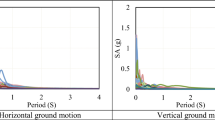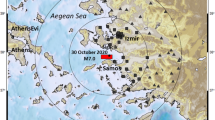Abstract
On the southwestern Korean Peninsula, a 74-earthquake swarm was recorded between April 26 and May 9, 2020, with a maximum local magnitude (ML) of 3.1. This is the third such event since instrumental seismic recordings began in South Korea in 1978. Because this area is located on a stable continent, this rare swarm event provides an opportunity to analyze earthquake sources and attenuation characteristics in this region. In this study, we first analyzed the intensity measure (IM) and the frequency content of the ground motions recorded during this swarm event. Next, we investigated the effects of earthquake magnitude and source-to-site distance on IMs, compared with those derived from international and local ground-motion models (GMMs). We found that the magnitude scaling slope (i.e., variation of IMs depending on ML) of the earthquake swarm records for ML ≥ 1.8 is similar to the slopes derived from GMMs, while for ML < 1.8, the slope from the records is steeper. For distance scaling (i.e., variation of IMs depending on source-to-site distance), the slopes from records are gentler than those from GMMs. This indicates that ground motion attenuates slowly in this region, compared to other global regions.
Similar content being viewed by others
References
Abrahamson, N.A., Silva, W.J., and Kamai, R., 2014, Summary of the ASK14 ground motion relation for active crustal regions. Earthquake Spectra, 30, 1025–1055.
Boore, D.M., Stewart, J.P., Seyhan, E., and Atkinson, G.M., 2014, NGA-West2 equations for predicting PGA, PGV, and 5% damped PSA for shallow crustal earthquakes. Earthquake Spectra, 30, 1057–1085.
Bozorgnia, Y., Abrahamson, N.A., Atik, L.A., Timothy D., Ancheta, T.D., Atkinson, G.M., Baker, J.W., Baltay, A., Boore. D.M., Campbell, K.W., Chiou, B.S.-J., Darragh, R., Day, S., Donahue, J., Graves, R.W., Gregor, N., Hanks, T., Idriss, I.M., Kamai, R., Kishida, T., Kottke, A., Mahin, S.A., Rezaeian, S., Rowshandel, B., Seyhan, E., Shahi, S., Shantz, T., Silva, W., Spudich, P., Stewart, J.P., Jennie Watson-Lamprey, J., Wooddell, K., and Youngs, R., 2014, NGA-West2 Research Project. Earthquake Spectra, 30, 973–987.
Campbell, K.W. and Bozorgnia, Y., 2014, NGA-West2 ground motion model for the average horizontal components of PGA, PGV, and 5% damped linear acceleration response spectra. Earthquake Spectra, 30, 1087–1115.
Chiou, B.S.-J. and Youngs, R.R., 2014, Update of the Chiou and Youngs NGA model for the average horizontal component of peak ground motion and response spectra. Earthquake Spectra, 30, 1117–1153.
Choe, S.J., 2012, Active fault map and seismic hazard map. Report NEMA-science-2009-24, National Emergency Management Agency, Republic of Korea, 900 p.
Douglas, J. and Halldórsson, B., 2010, On the use of aftershocks when deriving ground-motion prediction equations. Proceedings of the 9th US National and 10th Canadian Conference on Earthquake Engineering, Toronto, Jul. 25–29, paper No. 220.
Dysart, P., Snoke, J., and Sacks, I., 1988, Source parameters and scaling relations for small earthquakes in the Matsushiro region, southwest Honshu, Japan. Bulletin of the Seismological Society of America, 78, 571–589.
Emolo, A., Sharma, N., Festa, G., Zollo, A., Convertito, V., Park, J.H., Chi, H.C., and Lim, I.S., 2015, Ground-motion prediction equations for South Korea Peninsula. Bulletin of the Seismological Society of America, 105, 2625–2640.
Goda, K., 2015, Record selection for aftershock incremental dynamic analysis. Earthquake Engineering & Structural Dynamics, 44, 1157–1162.
Goda, K. and Taylor, C.A., 2012, Effects of aftershocks on peak ductility demand due to strong ground motion records from shallow crustal earthquakes. Earthquake Engineering & Structural Dynamics, 41, 2311–2330.
Goulet, C., Bozorgnia, Y., Abrahamso, N., Kuehn, N., Atik, L.A., Youngs, R., Graves, R., and Atkinson, G., 2018, Central and eastern North America gound-motion characterization - NGA-East final report. PEER Report No. 2018/08. Pacific Earthquake Engineering Research Center, Berkeley, 817 p.
Gutenberg, B. and Richter, C., 1954, Seismicity of the Earth and Associated Phenomena (2nd edition). Princeton, New Jersey, 310 p.
Kim, B. and Shin, M., 2017, A model for estimating horizontal aftershock ground motions for active crustal regions. Soil Dynamics and Earthquake Engineering, 92, 165–175.
Kraft, T., Wassermann, J., Schmedes, E., and Igel, H., 2006, Meteorological triggering of earthquake swarms at Mt. Hochstaufen, SE-Germany. Tectonophysics, 424, 245–258.
Lee, H., Park, H.-J., and Kim, B., 2020, Differences between main shock and aftershock ground motions derived from the Japanese KiK-net database. Soil Dynamics and Earthquake Engineering. https://doi.org/10.1016/j.soildyn.2020.106325
Ogata, Y. and Katsura, K., 2006, Immediate and updated forecasting of aftershock hazard. Geophysical Research Letters, 33, L10305.
Omori, F., 1894, On the after-shocks of earthquakes. Journal of the College of Science, Imperial University of Tokyo, 7, 111–120.
Rathje, E.M., Abrahamson, N.A., and Bray, J.D., 1998, Simplified frequency content estimates of earthquake ground motions. Journal of Geotechnical and Geoenvironmental Engineering, 124, 150–159.
Rathje, E.M., Faraj, F., Russell, S., and Bray, J.D., 2004, Empirical relationships for frequency content parameters of earthquake ground motions. Earthquake Spectra, 20, 119–144.
Richter, C.F., 1935, An instrumental earthquake magnitude scale. Bulletin of the Seismological Society of America, 25, 1–32.
Ross, Z.E., Cochran, E.S., Trugman, D.T., and Smith, J.D., 2020, 3D fault architecture controls the dynamism of earthquake swarms. Science, 368, 1357–1361.
Schaff, D.P., Beroza, G.C., and Shaw, B.E., 1998, Postseismic response of repeating aftershocks. Geophysical Research Letters, 25, 4549–4552.
Seo, J.W. and Lee, D.K., 2020, Earthquake swarm events occurred in Haenam, Jeollanam-do, are not expected as a fore-earthquake of the big one. Korea Meteorological Administration Press Release (2 June, 2020) (in Korean).
Sheen, D.H., Kang, T.S., and Rhie, J., 2018, A local magnitude scale for South Korea. Bulletin of the Seismological Society of America, 108, 2748–2755.
Son, M., Shin, J.S., Kim, G., and Cho, C.S., 2015, Epicenter relocation of two 2013 earthquake sequences in the Yellow Sea, Korea, using travel-time double-differences and Lg-wave cross-correlation. Geosciences Journal, 19, 295–303.
Tsuneishi, Y., 1970, Faulting associated with the Matsushiro swarm earthquakes. Bulletin of the Earthquake Research Institute, 48, 29–51.
Yun, K.-H., Park, D.-H., Chang, C.-J., and Sim, T.-M., 2008, Estimation of aleatory uncertainty of the ground-motion attenuation relation based on the observed data. Proceedings of the Earthquake Engineering Society of Korea Conference, Seoul, Mar. 21, p 116–123.
Acknowledgments
This work was supported by the Korea Meteorological Administration (KMA) with grant number KMA1365003180, and the National Research Foundation of Korea (NRF) grant funded by the Korea government (MSIT) (No. NRF-2019R1F1A1062791). Authors greatly appreciate their support. We also thank to KMA for allowing to deploy the seismic ground motion data and information for this study.
Author information
Authors and Affiliations
Corresponding author
Additional information
Publisher’s Note Springer Nature remains neutral with regard to jurisdictional claims in published maps and institutional affiliations.
Electronic Supplementary Material
Rights and permissions
About this article
Cite this article
Ahn, JK., Kim, B. & Kwak, D. Source and path effects of the ground motions recorded during the 2020 Haenam earthquake swarm in South Korea. Geosci J 25, 83–92 (2021). https://doi.org/10.1007/s12303-020-0048-1
Received:
Accepted:
Published:
Issue Date:
DOI: https://doi.org/10.1007/s12303-020-0048-1




